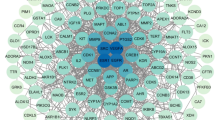Abstract
In AIDS treatments, it is an imperative problem to reduce the risk of the drug resistance. The previous study discussed which HIV-1 gene products are an ideal drug target not to develop drug resistance by applying some ideas of the graph theory, and suggested that the drug resistance would not develop if the drug target molecule functions as ”hub” in a chemical network where HIV-1 gene products interact directly or indirectly with intracellular agents in a HIV-1 host cell. The present study fortifies this suggestion in mathematical framework. The study develops the expression for a probability of drug resistance developing over the two different types: non-hub and hub of drug targets, and demonstrates that the hub drug target is more favorable for the drug resistance prevention than the non-hub one.
Preview
Unable to display preview. Download preview PDF.
Similar content being viewed by others
References
Volberding, P.A., Sande, M.A., Lange, J., Greene, W.C.: Global HIV/AIDS Medicine. Elsevier Inc., Amsterdam (2008)
Chiryo no tebiki 12th edn., http://www.hivjp.org/
Sugiura, W.: Progress in antiretroviral drugs. Virus 55, 85–94 (2005)
Harada, K., Ishida, Y.: A hub gene in a HIV-1 gene regulatory network is a promising target for anti-HIV-1 drugs. In: Proc. of AROB 14th, pp. 522–525 (2009)
Ptak, R.G., et al.: Cataloging the HIV Type 1 Human Protein Interaction Network. AIDS Research And Human Retroviruses 24(12), 1497–1502 (2008)
Zambrowicz, B.P., Sands, A.T.: Modeling drug action in the mouse with knockouts and RNA interference. Drug Discov. Today Targets 3, 198–207 (2004)
Winzeler, E.A., et al.: Functional characterization of the S. cerevisiae genome by gene deletion and parallel analysis. Science 285, 901–906 (1999)
Giaever, G., et al.: Functional profiling of the Saccharomyces cerevisiae genome. Nature 418, 387–391 (2002)
Baraba’si, A.L., Oltvai, Z.N.: Network biology: understanding the cell’s functional organization. Nat. Rev. Genet. 5, 101–113 (2004)
Albert, R., Jeong, H., Barabasi, A.L.: Error and attack tolerance of complex networks. Nature 406, 378–382 (2000)
Ooi, S.L., et al.: Global synthetic-lethality analysis and yeast functional profiling. Trends Genet. 22, 56–63 (2006)
Denome, S.A., Elf, P.K., Henderson, T.A., Nelson, D.E., Young, K.D.: Escherichia coli mutants lacking all possible combinations of eight penicillin binding proteins: viability, characteristics, and implications for peptidoglycan synthesis. J. Bacteriol. 181, 3981–3993 (1999)
Janoir, C., Zeller, V., Kitzis, M.D., Moreau, N.J., Gutmann, L.: High-level fluoroquinolone resistance in Streptococcus pneumoniae requires mutations in parC and gyrA. Antimicrob. Agents Chemother. 40, 2760–2764 (1996)
Hopkins, A.L.: Network pharmacology: the next paradigm in drug discovery. Nat. Chem. Bio. 4(11), 682–690 (2008)
Dancey, J.E., Chen, H.X.: Strategies for optimizing combinations of molecularly targeted anticancer agents. Nat. Rev. Drug Discov. 5, 649–659 (2006)
Han, J.D., et al.: Evidence for dynamically organized modularity in the yeast proteinprotein interaction network. Nature 430, 88–93 (2004)
Joy, M.P., Brock, A., Ingber, D.E., Huang, S.: High-betweenness proteins in the yeast protein interaction network. J. Biomed. Biotechnol. 2, 96–103 (2005)
Yu, H., Kim, P.M., Sprecher, E., Trifonov, V., Gerstein, M.: The importance of bottlenecks in protein networks: correlation with gene essentiality and expression dynamics. PLoS Comput. Biol. 3, e59 (2007)
Hwang, W C., Zhang, A., Ramanathan, M.: Identification of information flowmodulating drug targets: a novel bridging paradigm for drug discovery. Clin. Pharmacol. Ther. (published online) doi:10.1038/clpt.2008.12
Author information
Authors and Affiliations
Editor information
Editors and Affiliations
Rights and permissions
Copyright information
© 2009 Springer-Verlag Berlin Heidelberg
About this paper
Cite this paper
Harada, K., Ishida, Y. (2009). A Network Approach for HIV-1 Drug Resistance Prevention. In: Velásquez, J.D., Ríos, S.A., Howlett, R.J., Jain, L.C. (eds) Knowledge-Based and Intelligent Information and Engineering Systems. KES 2009. Lecture Notes in Computer Science(), vol 5712. Springer, Berlin, Heidelberg. https://doi.org/10.1007/978-3-642-04592-9_97
Download citation
DOI: https://doi.org/10.1007/978-3-642-04592-9_97
Publisher Name: Springer, Berlin, Heidelberg
Print ISBN: 978-3-642-04591-2
Online ISBN: 978-3-642-04592-9
eBook Packages: Computer ScienceComputer Science (R0)




